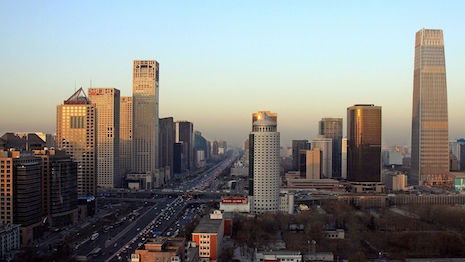 The Madrid luxury real estate market grew 10 percent in the last 12 months. Image credit: Knight Frank
The Madrid luxury real estate market grew 10 percent in the last 12 months. Image credit: Knight Frank
Urban luxury residential markets grew just 2.6 percent in the year to June 2018, the weakest annual growth rate since the fourth quarter of 2012, according to new research from Knight Frank.
Knight Frank’s Prime Global Cities Index for Q2 2018 attributes the weaker growth to several top markets increasing at a slower rate, as opposed to cities declining. Most of the faster-growing cities were in Asia, while Western European markets saw slower growth or even declines.
“The gap between the strongest and weakest performing city has shrunk from 33 to 20 percentage points in the last quarter," said Kate Everett-Allen, partner, international residential research at Knight Frank.
Growth slows
Per Knight Frank's report, three cities registered double-digit annual price growth: Guangzhou, Singapore and Madrid. This was down from seven during the previous quarter.
Guangzhou's luxury real estate market grew 11.9 percent over the last 12 months. However, this still marks a decline from the 16.1 percent growth last quarter.
 Beijing's luxury real estate market continues to grow. Image credit: Knight Frank
Beijing and Shanghai grew at the rates of 7.3 and 3.3 percent, respectively. While the Chinese government has scaled back a significant housing subsidy program, it is not expected to impact top-tier Chinese cities.
Elsewhere in Asia, Singapore grew 11.5 percent and Tokyo grew 9.4 percent from June 2017 to June 2018.
In the United States, San Francisco and Los Angeles both ranked in the top 10 for annual price growth. The former grew 9.5 percent, ranking fourth overall, and the latter grew 7.8 percent.
Beijing's luxury real estate market continues to grow. Image credit: Knight Frank
Beijing and Shanghai grew at the rates of 7.3 and 3.3 percent, respectively. While the Chinese government has scaled back a significant housing subsidy program, it is not expected to impact top-tier Chinese cities.
Elsewhere in Asia, Singapore grew 11.5 percent and Tokyo grew 9.4 percent from June 2017 to June 2018.
In the United States, San Francisco and Los Angeles both ranked in the top 10 for annual price growth. The former grew 9.5 percent, ranking fourth overall, and the latter grew 7.8 percent.
 Los Angeles saw its luxury real estate market grow almost 8 percent year-to-year. Image credit: Teles
California's Bay Area especially continues to see rapid growth, with luxury prices for real estate up an average of 13 percent from last year. Four of the 10 fastest-growing luxury markets are in Silicon Valley and the surrounding areas, including Santa Cruz, San Mateo, Santa Clara and Monterey (see story).
On the East Coast, real estate growth was much slower. Miami improved 3.3 percent, while New York saw a bump of just 0.1 percent.
Evolving property market regulations have partly contributed to the moderate price growth.
Hong Kong has instituted a vacancy tax, while Singapore will introduce higher rates for foreign buyers and developers. Dublin has tighter lending laws, coupled with a rising supply of luxury housing.
Mixed trends
The worldwide luxury real estate market has been giving buyers and sellers mixed signals recently.
In 2017, luxury homes saw their best annual growth rate in years. This growth can be attributed to rising consumer confidence, low interest rates, robust stock market performances and an increasingly stable global economy (see story).
While Chinese cities are outpacing American cities with their rate of growth, Chinese affluents are drawn to the United States real estate market.
With its reduced corporate tax, the U.S. is among the countries that have implemented policies encouraging immigration from affluents. Various European nations have also simplified policies for immigrants who wish to purchase property.
The United Kingdom and Ireland both moved up to second and third, respectively. Ireland, which had placed seventh in last year’s ranking, benefited from a high-quality education system and low corporate tax rate, as well as its proximity to Great Britain (see story).
Los Angeles saw its luxury real estate market grow almost 8 percent year-to-year. Image credit: Teles
California's Bay Area especially continues to see rapid growth, with luxury prices for real estate up an average of 13 percent from last year. Four of the 10 fastest-growing luxury markets are in Silicon Valley and the surrounding areas, including Santa Cruz, San Mateo, Santa Clara and Monterey (see story).
On the East Coast, real estate growth was much slower. Miami improved 3.3 percent, while New York saw a bump of just 0.1 percent.
Evolving property market regulations have partly contributed to the moderate price growth.
Hong Kong has instituted a vacancy tax, while Singapore will introduce higher rates for foreign buyers and developers. Dublin has tighter lending laws, coupled with a rising supply of luxury housing.
Mixed trends
The worldwide luxury real estate market has been giving buyers and sellers mixed signals recently.
In 2017, luxury homes saw their best annual growth rate in years. This growth can be attributed to rising consumer confidence, low interest rates, robust stock market performances and an increasingly stable global economy (see story).
While Chinese cities are outpacing American cities with their rate of growth, Chinese affluents are drawn to the United States real estate market.
With its reduced corporate tax, the U.S. is among the countries that have implemented policies encouraging immigration from affluents. Various European nations have also simplified policies for immigrants who wish to purchase property.
The United Kingdom and Ireland both moved up to second and third, respectively. Ireland, which had placed seventh in last year’s ranking, benefited from a high-quality education system and low corporate tax rate, as well as its proximity to Great Britain (see story).
